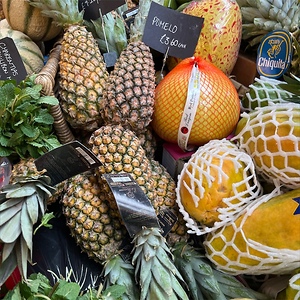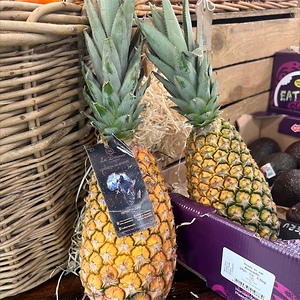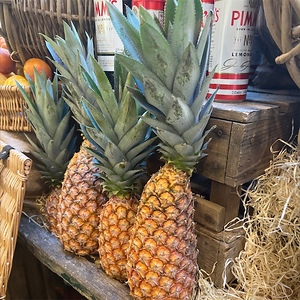


African Pineapples
Estimated Inventory, lb : 0
Description/Taste
African Sugarloaf pineapples are cylindrical in shape and taper towards the crown, like a cone. They weigh an average of 3 to 6 pounds, and are topped with a tightly-grouped crown of green, smooth, stiff, pointed-tipped leaves. They have a thin and waxy rind with hexagonal segments that contain small spikes, causing the exterior to be rough to the touch. African Sugarloaf pineapples are green when under ripe, and mature to a deep golden hue with pink and orange tones. The flesh is whiter than other varieties of pineapple, and is exceedingly sweet with hints of honey and almost no acidity. African Sugarloaf pineapples can reach up to a 15 on the brix scale. Unlike other varieties, the African Sugarloaf pineapple’s flesh is not woody or fibrous, including the edible core.
Seasons/Availability
African Sugarloaf pineapples are available year-round, with a peak season in mid-to-late summer.
Current Facts
African Sugarloaf pineapples are botanically classified as Ananas comosus, and are members of the Bromeliad family. Their name comes from the cone-like form, sugarloaf, in which refined sugar was traditionally produced before the late 19th century when sugar cubes and granulated sugar were introduced. African Sugarloaf pineapples are often called Pain De Sucre pineapples in France and Pan de Azucar in South America. They are also known as Kona pineapples, Kona Sugarloaf, or Brazilian White pineapples, depending on the growing region.
Nutritional Value
African Sugarloaf pineapples are an excellent source of manganese and a good source of potassium, calcium, vitamin C, and fiber. They also contain magnesium, phosphorus, copper, folate, and vitamins B1 and B6. Their overall nutritional content provides digestive and immune support, as well as anti-inflammatory benefits.
Applications
African Sugarloaf pineapples are most commonly enjoyed raw, however they can be used in cooked applications as well. Remove the rough skin with a knife, and slice the pineapple to eat raw. The flesh can also be juiced or pureed for cocktails, smoothies, and other beverages. Dice the pineapple small to use in baked goods, or as toppings for custards, cakes, and other pastries. Pair with other tropical flavors like banana, coconut, pineapple, or herbs such as mint or basil. For cooked applications, grill the pineapple, or add to sauces or braises with pork, chicken, or fish. You can also use African Sugarloaf pineapples in dishes such as pineapple fried rice, al pastor pork, pineapple salsa, and more. Fresh pineapple is highly perishable, and will keep at room temperature for just a few days. To extend its shelf life, store in the refrigerator for up to a week, or cut and freeze pieces for up to about 6 months. Fresh, cut pieces can also be stored in the refrigerator in an airtight container for about 5 days.
Ethnic/Cultural Info
Benin, a West African country, produces over 400 thousand tons of pineapples each year, making pineapples their third most important agricultural product. They grow two main varieties: the smooth cayenne and the Sugarloaf. In 2006, pineapple was one of the crops selected by the Benin government to help alleviate poverty across the county through establishing joint programs to bring producers, farms, and financial investors together. Benin pineapples are exported mostly to Nigeria, with a small percent going to European Union countries. In December of 2016, Benin’s government banned pineapple exports after receiving repeated warnings from the European Union about pineapples that were found to have been treated with the pesticide ethephon, which speeds up the coloring of the fruit. Benin farmers had apparently begun treating their crops with the pesticide as a response to the European market’s desire for yellow-colored fruit. This has had a crushing effect on Benin’s pineapple market, but they are slowly rebuilding their exports program, and new measures have been put into place to test for ethephon prior to shipping.
Geography/History
The pineapple industry in the Republic of Benin began around 1985, and has since stretched into Ghana, Togo, and parts of Nigeria. In 2014, the Nigerian government instituted a program called “Agribusiness Opportunities in Pineapple Production for Unemployed Youths” in an effort to help reduce poverty, increase food security, boost exporting profits, and bridge the gap between supply and demand.










